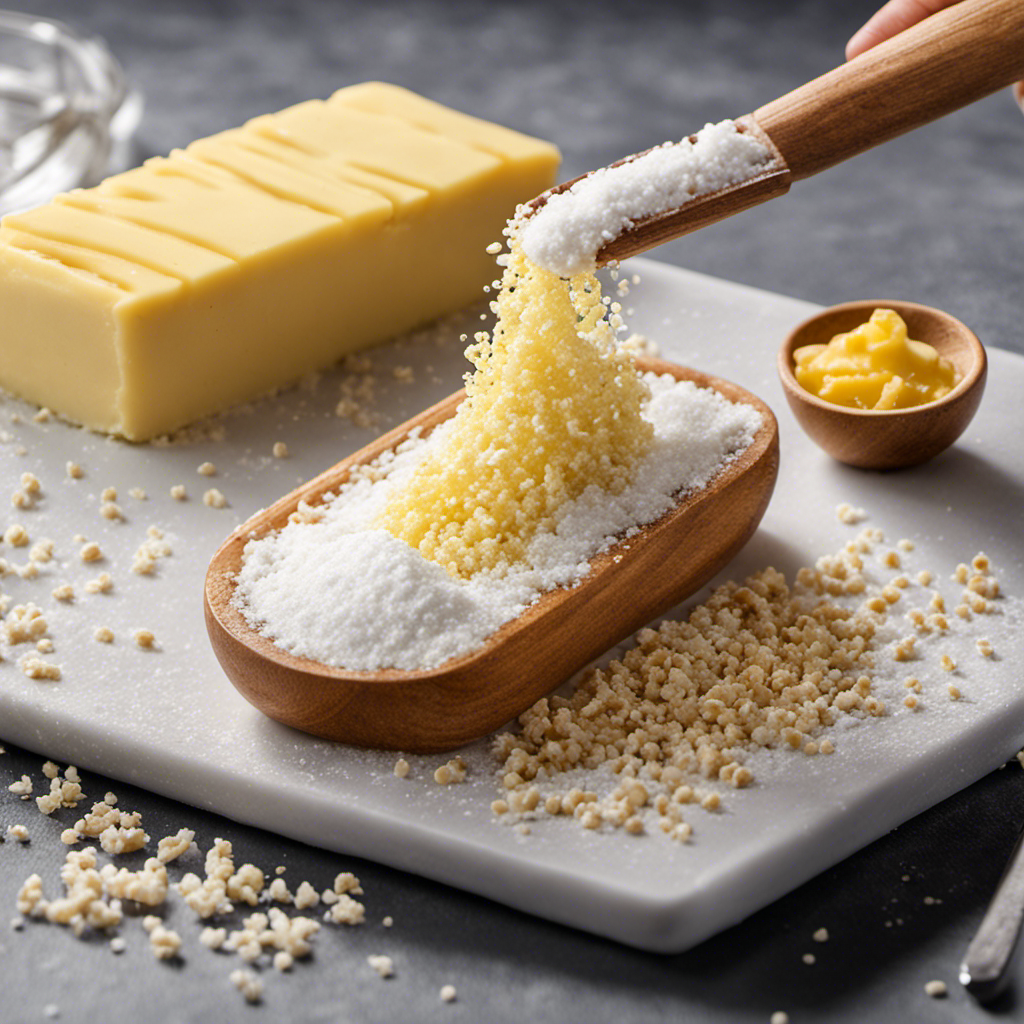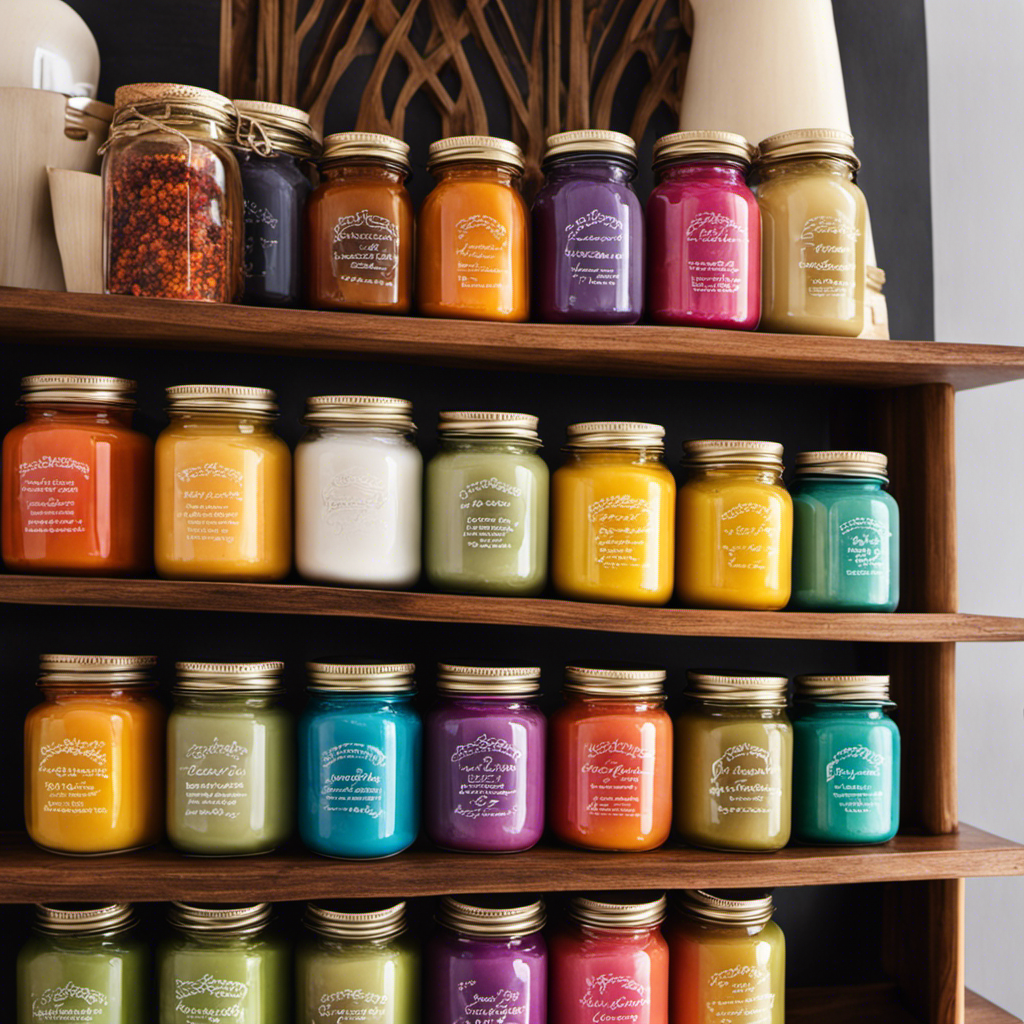I’m in disbelief! Were you aware that a single stick of salted butter can have as much as 1/4 teaspoon of salt? That’s quite a bit of sodium in that creamy goodness.
In this article, we’ll delve into the science behind salted butter sticks and explore the factors influencing the salt levels. Whether you’re a health-conscious consumer or just curious about your butter, stay tuned to learn more about how much salt is really in that tasty stick.
Key Takeaways
- Salted butter enhances flavor and balances richness and sweetness in baking.
- Salt acts as a natural preservative in salted butter.
- Salted butter contains high sodium levels, which can have health implications.
- Individuals with hypertension or heart disease should opt for low-sodium or unsalted butter.
The Science Behind Salted Butter Stick
I’ve always been curious about the science behind why salted butter sticks have a salty taste.
When it comes to baking, using salted butter can offer several benefits. Salt plays a crucial role in enhancing the flavor of salted butter sticks. The addition of salt in butter helps to balance out the richness and sweetness, creating a more complex and enjoyable taste.
It also acts as a natural preservative, extending the shelf life of butter by inhibiting the growth of bacteria. In baking, the presence of salt in salted butter can enhance the overall flavor profile of baked goods, bringing out the sweetness and adding depth to the final product.
Understanding the Salt Content in Salted Butter Stick
There’s a surprising amount of sodium in a stick of salted butter. Many people may not realize just how much salt they are consuming when using salted butter in their cooking and baking. The high sodium content in salted butter can have health implications, especially for those who need to watch their sodium intake, such as individuals with high blood pressure or heart conditions.
To better understand the salt content in salted butter, let’s compare it to unsalted butter:
| Salted Butter | Unsalted Butter | |
|---|---|---|
| Sodium (mg) | 90 | 2 |
| Total Fat (g) | 11 | 11 |
| Calories (kcal) | 100 | 100 |
As you can see, salted butter contains 90mg of sodium per serving, while unsalted butter only contains 2mg. This significant difference in sodium content makes unsalted butter a healthier option for those concerned about their sodium intake.
How Salted Butter Stick Compares to Unsalted Butter Stick
Comparing the sodium content between salted and unsalted butter sticks, the difference in sodium levels is quite significant. Salted butter contains a higher amount of sodium compared to unsalted butter, as the name suggests.
The primary purpose of adding salt to butter is to enhance its flavor. The salt in salted butter acts as a natural preservative, extending the shelf life of the butter. Additionally, the added salt can also help to balance out the richness of the butter, making it a popular choice for baking and cooking savory dishes.
However, it’s important to note that consuming excessive amounts of sodium can have negative health effects, such as increased blood pressure. Therefore, moderation is key when using salted butter in your recipes.
Moving forward, let’s explore the factors that influence the salt levels in salted butter sticks.
Factors Influencing the Salt Levels in Salted Butter Stick
To understand the factors affecting the salt levels in salted butter sticks, it’s important to consider the production process and the specific brand of butter chosen.
Salted butter is made by adding salt to cream before churning it into butter. The amount of salt added can vary depending on the brand and the desired flavor profile. While salted butter offers benefits such as enhanced flavor and increased shelf life, it’s important to be mindful of the health implications of consuming too much sodium. High salt intake has been linked to increased risk of hypertension and heart disease. Therefore, individuals with these conditions or those watching their sodium intake should opt for low-sodium or unsalted butter.
Transitioning into the subsequent section about tips for choosing the right salted butter stick for your needs, it’s essential to consider factors such as salt content, brand reputation, and personal preferences.
Tips for Choosing the Right Salted Butter Stick for Your Needs
When selecting the perfect salted butter for my needs, I consider factors such as brand reputation, flavor profile, and personal preferences.
Brand reputation: I look for trusted brands that have a good track record of producing high-quality butter. This ensures that I’m getting a reliable product.
Flavor profile: I prefer salted butter with a balanced and smooth flavor. It should enhance the taste of my dishes without overpowering them.
Personal preferences: I take into account my own dietary requirements and health concerns. For example, if I need to watch my sodium intake, I may opt for a lower salt content in the butter.
Choosing between salted and unsalted butter ultimately depends on the intended use. Salted butter is great for spreading on bread or adding flavor to cooked dishes, while unsalted butter is more versatile for baking and allows for better control over salt levels in recipes.
Frequently Asked Questions
How Many Calories Are in a Salted Butter Stick?
In terms of calories, a salted butter stick typically contains around 810 calories. However, it’s important to consider the health effects of consuming salted butter.
Excessive consumption of salted butter can contribute to high cholesterol levels and increase the risk of heart disease. It’s recommended to consume butter in moderation and opt for unsalted varieties whenever possible to reduce salt intake.
Can Salted Butter Stick Be Used in Baking?
Salted butter stick can definitely be used in baking. It adds a rich and savory flavor to baked goods, enhancing their taste.
However, it’s important to note that the salt in salted butter can affect the texture of your creations. Too much salt can make the baked goods denser and affect the rise.
It’s always a good idea to adjust your recipe accordingly if you’re using salted butter instead of unsalted.
Does Salted Butter Stick Have a Longer Shelf Life Than Unsalted Butter Stick?
When comparing the shelf life of salted butter sticks to unsalted ones, it’s important to note that the presence of salt can help extend the shelf life. Salt acts as a natural preservative, inhibiting the growth of bacteria and mold.
However, it’s crucial to consider that the exact shelf life can vary depending on factors such as storage conditions and the brand of butter.
Additionally, it’s worth mentioning that while salted butter may have a longer shelf life, it also contains more sodium, which can affect certain individuals with dietary restrictions.
Is Salted Butter Stick More Expensive Than Unsalted Butter Stick?
Cost comparison is an important factor when deciding between salted and unsalted butter sticks. It’s worth noting that salted butter sticks are typically more expensive than unsalted ones. However, this price difference may vary depending on the brand and location.
Additionally, when considering health benefits, it’s important to note that excessive salt intake can be detrimental to one’s health. Therefore, individuals who are watching their sodium intake may prefer unsalted butter sticks for a healthier option.
Can Salted Butter Stick Be Used as a Spread on Bread or Toast?
When it comes to spreading butter on bread or toast, I can’t help but wonder about the alternatives to salted butter. Are there any health benefits to using salted butter? It’s a question worth exploring.
But before we dive into the specifics, let’s first discuss the versatility of salted butter as a spread. It adds a savory touch to any slice, making it a popular choice for many.
Conclusion
In conclusion, the salted butter stick contains a specific amount of salt that enhances its flavor and preservation. Understanding the salt content in salted butter stick is essential for those who want to control their sodium intake.
Comparing salted butter stick to unsalted butter stick allows consumers to make informed choices based on their preference and dietary needs. Various factors influence the salt levels in salted butter stick, such as the brand, production process, and region. Consider these factors when choosing the right salted butter stick for your needs.
Remember, a pinch of salt can add a world of flavor.










